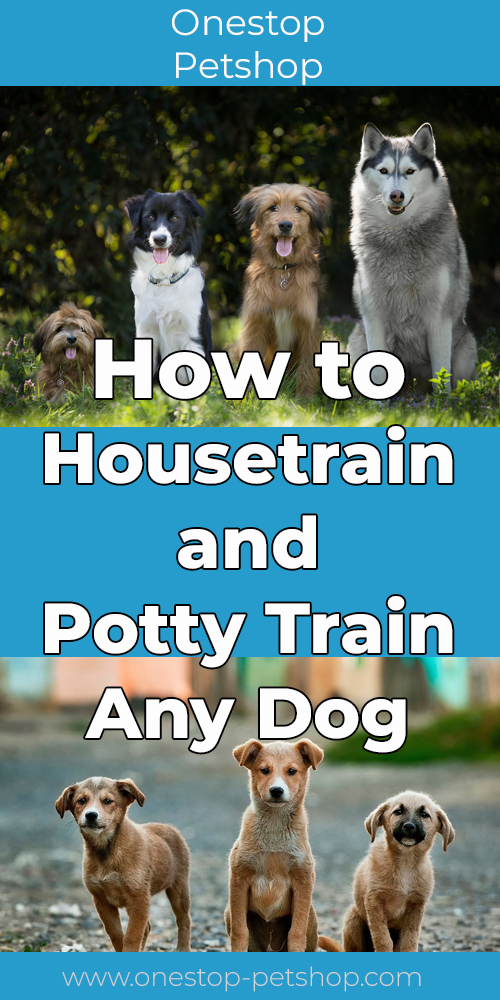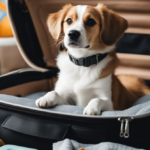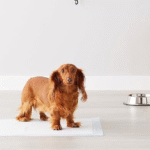How to Housetrain and Potty Train Any Dog – a quick overview.
Did you get a cute new puppy? Or maybe you just adopted a wonderful dog from the shelter? Either way, one of the first things you must be eager to do with your new pooch is to housetrain or potty train it.
The good news is, you can teach both young and old dogs where to do potty. It’s not difficult, but it will require patience and consistency.
Overview
Will Puppies and Dogs Need Different Kinds of Potty Training?
In a way, yes. But not because one is more difficult to train than the other!
In general, both puppies and dogs only need you to be consistent with your training so they’ll understand and learn what to do. But training a puppy will need more patience because they’ll need to go a lot more often.
Puppies are small, so they have smaller tummies and bladders. Unlike adult dogs, puppies can only hold their poo and pee in for so long. The length of hour is the same as their age in months. So if your pup is a couple of months old, it’ll need a bathroom break every couple of hours.
Adult dogs, on the other hand, will need bathroom breaks at least twice a day. You’ll also need to reinforce training the same amount of time, but training adult dogs isn’t as intensive as training puppies.
How Do You Start Training Your Dog?
The first thing you need to do is dedicate yourself to your training. This means possibly taking time off from work or school. If this isn’t possible, delegate training your dog to a family member who can be in the house for the entire duration of potty training.
The next thing to do is to establish a routine. Both puppies and dogs thrive when given routines, because it gives them a sense of purpose as they anticipate what comes next.
Plan your schedule well. Try to fit in your dog’s feeding times, playtime, walks, and bathroom breaks within your own daily schedule. Make sure the schedule is consistent, so your dog can anticipate the next activity.
The most important thing: make sure you stick to your schedule! Being consistent is a key factor when it comes to housetraining. The more consistent and reliable you are, the faster will your pooch finish housetraining.
How Should You Schedule Routines?
Scheduling mealtimes and bathroom breaks for puppies should go hand-in-hand. This is because when your puppy eats on schedule, it will also poo and pee on schedule.
The first thing that should be on your routine is a bathroom break. Your pup needs to go after a long night’s rest, after all. After that, you can schedule your pup’s feeding times.
Next, schedule appropriate bathroom breaks after the correct number of hours after each feeding. You can then add in schedules for playtime, walks, grooming, etc.
Also remember to schedule bathroom breaks every time your puppy wakes up from a nap. It will also need to go potty during and after walking and playing.
The same set of rules apply to older dogs, too, though they don’t need as many bathroom breaks as puppies. You can schedule bathroom breaks in the morning, an hour or two after meals and drinks, after naps, and during and after walking and playing.
Are There Tested Training Methods that Work for Housetraining?
You can try two safe, humane, and proactive training methods: crate training and positive reinforcement.
Crate training is the easiest way to train your pooch. You’ll only need a crate or kennel for your dog.
This method works because dogs don’t like to dirty the area where they sleep. Even puppies have this innate sense. If you give your puppy or dog a crate to sleep in, teaching it where and when to go potty will be much easier.
You must make sure that the crate is just big enough for your pooch to stand, sit, and walk around comfortably in. Don’t give it a crate that’s too big, or else it might just convert an area inside the crate as its bathroom.
You can herd your pup or dog inside its crate after every feeding, walk, or playtime. You can take your pooch out when the scheduled bathroom break comes and take it to the designated potty area.
For positive reinforcement, this is the method of giving treats such as snacks or praise whenever your pooch does something good. The more you reinforce its good behavior with something nice, like a dog biscuit or a belly rub, the more will your will associate the action it just did with something positive, and will likely to keep doing it again.
So to further strengthen your potty training, you can use positive reinforcement whenever your pooch or dog poos or pees at its designated spot. You can use verbal praises and gentle pats if you don’t want to use treats.
You can use either or both to train your puppy or dog. Observe and see which method works best for your pooch.
What Tips Will Make Potty Training Successful?
Remember to use the same potty spot. Don’t confuse your pooch by appointing one area one day and another area the next.
Accidents will happen, especially with puppies. Don’t punish your pup when this happens! Just calmly clean the area and move along.
Appoint a command word or phrase for the deed. Watch for your dog’s cues. Let it circle and sniff the potty area for a while, and when it’s about to go, say your command. It can be any word or phrase, but make sure it’s distinguishable from your other commands. And as always, be consistent with your command word or phrase.
With these tips and guidelines, housetraining any puppy or dog will be easy and successful.
We hope you enjoyed our Quick Overview article. We also hope that you learned a bit more and we would appreciate if you would share this article with other dog owners. Also read our article 10 good gift ideas for a dog
You can have a look at all our Dog Products Here
If you want to learn more about How to Housetrain and Potty Train Any Dog, have a look at the Dog Training 101: How to Completely Train Your Dog.
We hope you like our content and that you will come back for more. Be sure to check out the other articles here on the website and send us a message if you have a great idea for a topic! We love feedback! If you haven’t already, don’t forget to follow us on social media!
Want to learn more about the Shih Tzu? Read our Shih Tzu articles:
What you should know about the dog breed Shih Tzu
Do Shih Tzus Get Along With Cats?






